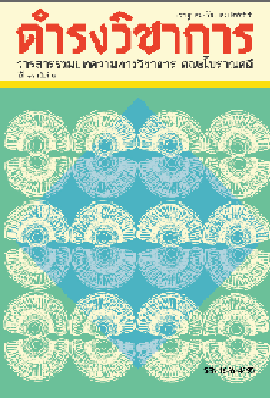CONCEPT ON THE BUILDING OF WOODEN BUDDHA IMAGES DURING LANNA PERIOD
Keywords:
พระพุทธรูปไม้, ล้านนา, ศิลปกรรมAbstract
Pra-Chao-Mai is an image of the Buddha made of wood. It is concerned with belief of “A-Ni-Song”, which means virtue will be gained by making favourable sacrifices for Buddhism. The Lanna People (Natives who live in the area formerly comprising the old Kingdom of Lanna) believe that their sincere devotion will assist them in obtaining merit, even when the good things they’ve done are less worthy. According to Lanna history, belief in A-Ni-Song has existed since the dynasty of Mang Rai. It referred to the building of a statue of the Buddha made of sandalwood by Phaya Muang Kaew. However,the oldest evidence which has recently been found is from 1704. It mentions to the making of Buddha images which were frequently made at that time. Until the end of Burmese rule, the Kingdom of Lanna captured and moved many Tai ethnic groups, including Tai Lue, Tai Kuen, and Tai Yong where they settled down in the kingdom. This move had an influence on the form of Buddha images which had been obviously changed. Due to people’s faith in Buddhism, those of Pra-Chao-Mai were built for worshiping the Buddha. Their form was based on traditional forms of each native expert sculptor group and available local materials for making as well. Therefore, those statues of the Pra-Chao-Mai in this era had various identities. Nevertheless, they have the same purpose which is to support Buddhism until B.E. 5000. Going forward from this period, the focus of the building of sacred statues was for worship by all Buddhists and for worshiping other gods in the traditional people’s faiths, for praying to ancestors and other deceased creatures, to redeem a vow to the Buddha, and for honour and virtue for all contributors. People attend buildings containing the Buddha’s image with the hope of attaining A-Ni-Song’s three forms of happiness: the happiness on the earth, the happiness in heaven, and the happiness of nirvana. They also wish to be reincarnated as a Buddhist saint in the next era of Maitreya (in B.E. 5000), to ascend to heaven, and to have faith healing, and /or to become a sage.
The new form of Pra-Chao-Mai was created by a new era of sculptor. The rationale for building is still linked with the Buddhists’ belief that they will gain lot of A-Ni-Song by creating Buddha images for their religion. These will help them find happiness in their current, the next life, and the life after the next life, as the inscription on base of Pra-Chao-Mai says “Happiness on the Earth, Happiness on Heaven, and Happiness of Nirvana, Amen”
References
กรมศิลปากร. พระพุทธรูปปางต่างๆ. กรุงเทพฯ : บริษัท รุ่งศิลป์การพิมพ์จํากัด, 2548.
วิเชียร สุรินต๊ะ และอุไร ไชยวงค์. ผู้แปล. อานิสงส์สร้างพุทธรูป. เชียงใหม่ :สถาบันวิจัยสังคม มหาวิทยาลัยเชียงใหม่, ม.ป.ป..
วีระศักดิ์ ของเดิม. เอกสารประกอบการประชุมเชิงวิชาการ เรื่อง การอนุรักษ์ศิลปกรรมทางพุทธศาสนาในเขตอําเภอแม่ทะ จังหวัดลําปาง. เชียงใหม่: ศูนย์โบราณคดีภาพเหนือ คณะสังคมศาสตร์มหาวิทยาลัยเชียงใหม่, 2551.
พระรัตนปัญญา. ชินกาลมาลีปกรณ์. กรุงเทพฯ: กรมศิลปากร, 2518.
สงวน โชติสุขรัตน์. ตํานานพระแก่นจันทร์. กรุงเทพฯ : โอเดียนสโตว์, 2551.
โสภิตขันตยาภรณ์, พระครู. ประวัติวัดปงสนุกเหนือและประวัติบันทึกประจําปีของพระอโนชัยธรรมจินดามุนี. ลําปาง: สหกิจการพิมพ์, 2539. พิมพ์เนื่องในการทําบุญฉลองวิหาร ศาลาราย ลานคอนกรีต และงานประเพณีประจําปี มกราคม 2539.
Downloads
Issue
Section
License
บทความนี้เป็นผลงานของข้าพเจ้าแต่เพียงผู้เดียว และ/หรือเป็นผลงานของข้าพเจ้าและผู้ร่วมงาน ตามชื่อที่ระบุในบทความจริง และเป็นผลงานที่มิได้ถูกนำเสนอหรือตีพิมพ์ที่ใดมาก่อน




